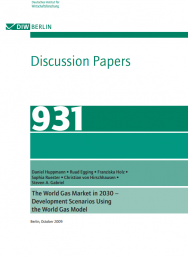
The World Gas Market in 2030: Development Scenarios Using the World Gas Model

Abstract
In this paper, we discuss potential developments of the world natural gas industry at the horizon of 2030. We use the World Gas Model (WGM), a dynamic, strategic representation of world natural gas production, trade, and consumption between 2005 and 2030. We specify a “base case” which defines the business-as-usual assumptions based on forecasts of the world energy markets. We then analyze the sensitivity of the world natural gas system with scenarios: i) the emergence of large volumes of unconventional North American natural gas reserves, such as shale gas; ii) on the contrary, tightly constrained reserves of conventional natural gas reserves in the world; and iii) the impact of CO2-constraints and the emergence of a competing environmental friendly “backstop technology”. Regional scenarios that have a global impact are: iv) the full halt of Russian and Caspian natural gas exports to Western Europe; v) sharply constrained production and export activities in the Arab Gulf; vi) heavily increasing demand for natural gas in China and India; and finally vii) constraints on liquefied
natural gas (LNG) infrastructure development on the US Pacific Coast. Our results show considerable changes in production, consumption, traded volumes, and prices between the scenarios. Investments in pipelines, LNG terminals and storage are also affected. However, overall the world natural gas industry is resilient to local disturbances and can compensate local supply disruptions with natural gas from other sources. Long-term supply security does not seem to be at risk. Keywords: natural gas, investments, reserves, climate policy.
- Issues:
- Infrastructure, Energy, Natural Resources
- Region:
- Global
- Year Published:
- 2009
- Authors:
- Daniel Huppmann, Ruud Egging, Franziska Holz, Sophia Ruester, Christian von Hirschhausen, Steven A. Gabriel
- Institution:
- German Institute for Economic Research (DIW Berlin)

